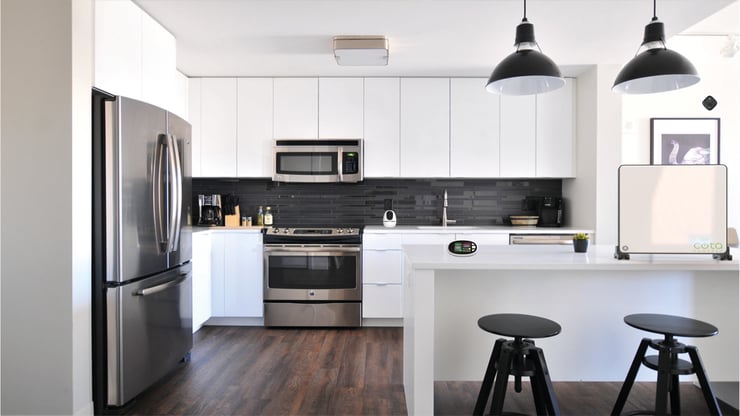
In Archos' depiction, the transmitter panel on the right is sending power to the air-quality monitor on the counter.
I've never been impressed by wireless charging devices. Sure, you no longer need to plug a wire into your smartphone, mouse, et cetera, but you still need to place it on a charging pad to charge it. And placing it on a pad doesn't save that much time over plugging a cable into it. Over-the-air charging, on the other hand, is closer to what I envisioned when I first heard the term wireless charging. You're not required to lay your device on any product in order for it to recharge. That vision should soon become a reality with true wireless charging products, like a smartwatch and smart home camera expected to debut next year.
On Tuesday, Archos, a French company that makes Android-powered tablets and smartphones, air purifiers, and Safe-T Mini, a cryptowallet, announced a partnership with Ossia, the Washington-based maker of over-the-air charging technology. Archos is currently making plans to design and build a smartwatch, indoor security camera, air monitor, and smart tracker that can charge their batteries without using a cable or charging pad.
Each device will hold a Cota Power Receiver, which is a small silicon chip that sends out a beacon signal that Ossia says is harmless. That signal bounces off any inanimate objects in its path in order to hit a Cota transmitter. Once that signal is received by the Cota transmitter, it responds by sending power over the air via a 5.8 GHz frequency to the device holding the receiver. According to Ossia, the devices speak to each other 100 times per second.
Note that, in order to conserve energy, the transmitter only sends out power if a device with a receiver is within range. In 2020, when Ossia demoed the consumer-facing Cota Home product to me at the CES trade show in Las Vegas, it said the range for the 11.8×11.8-inch transmitter panel was 30 feet and that wireless charging could even work with a device that was in a pocket or drawer. There's also an app that lets you view the devices connected to Cota, since it can power many devices simultaneously.
I've tried Cota in the form of a Spigen-brand smartphone case that wirelessly charges the phone wearing it. In the demo, I saw the transmitter pick up the receiver's signal instantly. If it weren't for the decently sized panel sitting on the table, it would've seemed like magic.
Currently, Cota has mostly found a home among businesses, including KonnectOne, which makes connected and broadband products for mobile operators and other businesses, and Sensata-Xirgo, which uses Cota for a trailer-tracker solution. This week's news promises to bring the consumer-friendly Cota Home tech into houses instead of stores.
Archos didn't get very specific about the products coming out. It said the smartwatch will have all the things expected of a health tracker, namely a blood pressure and sleep-quality monitor, pedometer, and GPS. Archos also said it "will never need to charge via a cable."
Additionally, Archos plans to release a Cota-powered indoor wireless camera, as well as a smart tracker that can be used on pets or kept in a purse. According to the announcement, the tracker "will automatically be located and wirelessly charged enough to get a few days of autonomy."
An air quality and temperature station is in the works, too. Wireless charging will enable it to move from room to room without worry about when it last saw its charging base. Tracking devices was an important factor for Archos' wireless charging gadgets.
"The Cota system was selected by Archos because of its unique ability to automatically track a device to send and receive information without the use of complex algorithms or the need to shut down when the path of delivery is interrupted and for its ability to send radio frequency-based power while avoiding people and pets," Archos' announcement said.
Archos didn't offer a firm release date beyond the 2022 "target," but product development will be shown off in January at CES.
While Ossia has FCC approval to run its tech at 2.4 GHz in the US, it has yet to receive 5.8 GHz approval. The company still expects Archos' products to debut in the US in "late 2022 or 2023," an Ossia spokesperson told Ars Technica.
And if you're curious about those smartphone cases, Ossia told us that, although the COVID-19 pandemic slowed things down, "Ossia is still working with Spigen and other manufacturers to build and bring a Cota Forever Sleeve to market in the US and globally." The company didn't provide an expected release date.
